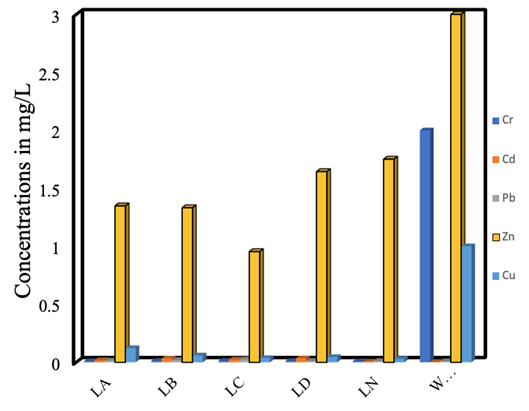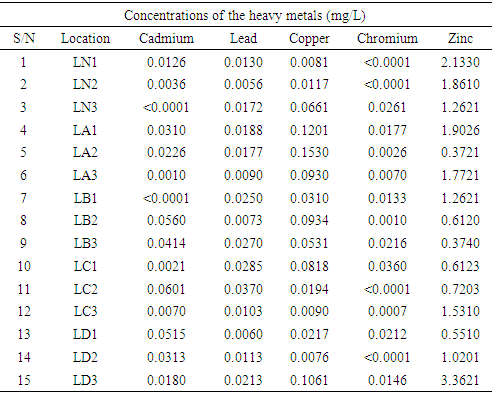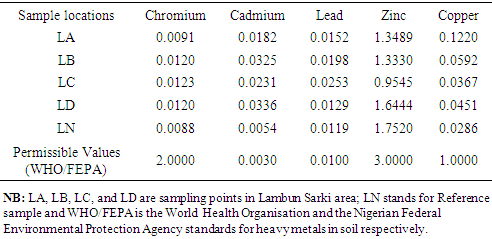-
Paper Information
- Next Paper
- Paper Submission
-
Journal Information
- About This Journal
- Editorial Board
- Current Issue
- Archive
- Author Guidelines
- Contact Us
Resources and Environment
p-ISSN: 2163-2618 e-ISSN: 2163-2634
2020; 10(1): 4-9
doi:10.5923/j.re.20201001.02

Assessment of Heavy Metals in Soils Samples from Lambun Sarki Irrigation Sites of Katsina Metropolis
Usman Armaya’u1, Zakariyya Uba Zango1, Haliru Aivada Kadir2, Suleiman Rabiu Musawa1
1Department of Chemistry, Al-Qalam University Katsina, Katsina, Nigeria
2School of Chemical Sciences, Universiti Sains Malaysia, Pulau Penang, Malaysia
Correspondence to: Zakariyya Uba Zango, Department of Chemistry, Al-Qalam University Katsina, Katsina, Nigeria.
| Email: |  |
Copyright © 2020 The Author(s). Published by Scientific & Academic Publishing.
This work is licensed under the Creative Commons Attribution International License (CC BY).
http://creativecommons.org/licenses/by/4.0/

Increase in environmental pollution caused by heavy metals released from anthropogenic activities due to ongoing rapid economic boost of industrialization and urbanization is becoming a global environmental problem due to their toxic and non-biodegradable nature. In this study, determination of heavy metals was conducted in soil sample obtained from Lambun Sarki irrigation site in Katsina metropolis, Nigeria. The sample was prepared in the laboratory using aqua regia acid digestion. Afterward, heavy metals (Cr, Cd, Cu, Pb, and Zn) were determined using Atomic Absorption Spectrophotometer (AAS) and the results obtained revealed that the soil from the area was heavily contaminated with Cadmium and Lead in comparison to the World Health Organization (WHO) and Nigerian Federal Environmental Protection Agency (FEPA) permissible limits. Further, observation shows that there exists a gradual red-shift in the level of these heavy metals as evident from the results obtained. The contamination of the soil by Pb and Cd could be associated with the anthropogenic activities being carried out around the farmland and the sewage water used in irrigation.
Keywords: Environment, Irrigation, Heavy Metals, Pollution, Soil
Cite this paper: Usman Armaya’u, Zakariyya Uba Zango, Haliru Aivada Kadir, Suleiman Rabiu Musawa, Assessment of Heavy Metals in Soils Samples from Lambun Sarki Irrigation Sites of Katsina Metropolis, Resources and Environment, Vol. 10 No. 1, 2020, pp. 4-9. doi: 10.5923/j.re.20201001.02.
Article Outline
1. Introduction
- Soil as a basic human environment is currently facing with threats from various forms of pollutions. These pollutions are mostly caused by anthropogenic activities due to the ongoing rapid economic boost, even though some occur as a result of natural causes (Sule et al., 2016). Pollution by heavy metals is a vital issue due to the toxic effects it poses on humans, flora and fauna plants coupled with their non-biodegradable nature, hence it becomes a key area in need of continuous attention of researchers (Garba et al., 2016). In addition, considering the fact that the soil forms the major sink of heavy metals in the environment, therefore, it plays a vital role in the overall metal cycle in the environment (Liu, et al., 2013). However, as a result of the disturbance and acceleration of the naturally occurring geochemical cycle of metals by anthropogenic activities and natural causes, most of the soils of the rural and urban environments are contaminated with one or more heavy metals to the extent that it posed a high risk to human health, animals, plants, ecosystems and other media (Jagaba et al., 2019; Ikpesu and Dickson, 2016).. Access to sufficient amounts of safe and nutritious food is paramount to sustaining life and promoting good health. However, unsafe or contaminated food can cause health-related issues such as food poisoning, diarrhoea, and cancers. Food contaminations impede socioeconomic development by straining health care systems, harming national economy, tourism and trade. It is noteworthy that the factors responsible for foodborne diseases have often been underestimated, this could be due to negligence, underreporting and difficulty to establish fundamental relationships between food contamination and the resulting illness or cause of death. Thus, it grossly affects public health, welfare, and economy (World Health Organisation, 2015).Basically, we do understand that vegetables serve as a major source of our daily diets which are regarded as an economic crop and a viable template for nutrients such as protein, vitamins, and minerals. It is essential to state that the vegetable fields around Katsina metropolis are greatly affected by the increasing presence of heavy metals concentration which is resulting from various forms pollution routes such as sewage irrigation, metal works (operating near the farmland), vehicular emission, fertilizers (being applied regularly), etc. A sector like Lambun Sarki which is situated in the heart of Katsina metropolis and being it one of the largest and reliable sources of Vegetables in the City, when contaminated with various toxic chemical species will affect the safety and quality of the food as well as the health status of the populace in focus (Jagaba 2018; Abubakar et al., 2016; Shi, et al., 2011). Hence it is vital to investigate the soil in which these vegetables are being grown.Heavy metals are often referred to as a special group of the element that has the potential to become toxic when present at high concentrations (Imam and Zango, 2018). While it is quite difficult to list or specify all the heavy metals found in soils as there exist over 50 of such elements, scientifically, those within the range of Vanadium (atomic mass 50.9) to Uranium (atomic mass 238) constitute the group of natural heavy metals and metalloids, except for halogens and the noble gases, which are non-metals (Vodyanitskii, 2016). Amongst them are seven heavy metal which includes Zn, Cd, Cu, Hg, Ni, Cr, and Pb, which is considered to be the most commonly found in contaminated areas (Garba 2015; Galadima 2012). Heavy metals occur through anthropogenic activities and it is naturally present in the soil through processes such as weathering, erosion of parent rocks, atmospheric deposition and volcanic activities but their concentration is rarely at toxic levels (Khan, et al., 2013; Ikpesu and Dickson, 2016). Often, most of the heavy metals accumulated in the soil are washed by heavy rain and consequently ends up into the water bodies such as ponds, river, sea and ocean where they exert toxic effects to living organisms (Jagaba et al., 2020). The excess of these heavy metals in soils is toxic to humans and other animals. The continuous uptake of heavy metals is associated with harmful effects on both human beings and animals (Lai et al., 2010; John and Andrew, 2011). This is because the toxicity of heavy metals can cause damage to the central nervous system, mental problems, reduced energy levels and damage to blood composition, kidneys, lungs, liver and other vital organs in the body while a chronic exposure affects the physical functions and muscular processes. It has been reported that long-term contact with some cancer-causing heavy metals or their compounds may eventually lead to cancer (Ikpesu and Dickson, 2016). Generally, considering the non-biodegradable nature of heavy metals in the soil, they are known to persist for a very long time thereby resulting in accumulation beyond tolerance and permissible limit, thus their toxic nature affects our ecosystem (Khan, et al., 2010). The soil of Lambun Sarki has been under cultivation regularly for over some decades, the system of farming in the area is still regarded as local because most of the farmers utilize this area as a means producing food crops for income and livelihood. Activities being carried out around the area of interest includes inappropriate application of fertilizer, disposal of toxic materials (batteries, petrochemical waste, metallurgical waste) and industrial effluents immensely poses a huge threat and it is a matter of concern for the safety of the people. In order to avoid the possible negative effect of consuming vegetables with high concentrations of heavy metals, it is paramount to investigate and report the findings to the appropriate authorities in Katsina metropolis. This is aimed towards creating awareness about the risk posed by the presence of heavy metals at dangerous levels in our society.According to the previous study, the contamination of the soil by heavy metals is a result of increasing use of the metals due to industrialization and urbanization which facilitate pollutants containing these metals into our environment (Jagaba et al., 2020; Najib, et al., 2012). Conventionally, there exists the presence of heavy metals in agricultural soil with their concentration set at minimal or negligible when compared to relevant standards. However, as a result of anthropogenic activities taking place around us, the concentrations of the heavy metals in an area can be increased to a significantly high extent which becomes a focus of concern (Guo, et al., 2013). If heavy metals are present in a particular agricultural soil, it can affect the soil function which will subsequently affect the plant growth on the soil, thus leading to the transfer of the heavy metals to the plants cultivated on the soil. This poses a risk to human life, as such it should be taken seriously. It is on this basis that the present study which entails investigating the soil in Lambun Sarki area (Katsina state, Nigeria) for the quantification of heavy metals concentration. This study will help to reveal the nature of the soil and ascertain the safety of food cultivated in the farming areas of Lambun Sarki. Figure 1 depicted various modes in which contamination due to heavy metals occurs and how it gets into human system.
 | Figure 1. Flow Chart showing the mode of contamination caused by heavy Metals in various matrices. Source: (Kosek-Hoehne, et al., 2017) |
1.1. Description of Study Area
- In terms location, the Lambun Sarki area is a vegetable garden located in Kofar Marusa, Katsina metropolis of Katsina state, Nigeria with latitude of 12°59'18.60"N and a longitude of 7°37'1.86"E. Initially, it was a small garden in which a small stream originating from far outside the town around the steel rolling company passes through the area as “sewage sludge”. This was used to provide water for irrigation in the garden. As time elapse, soil erosion and sewage disposal increase as a result of the rise in the population which led to the widening of the stream, hence plenty of water became available in the area for irrigation. It then flows through the town of Katsina thereby serving as a sludge in which contaminants are deposited on a regular basis such as industrial waste, mechanic waste, vulcanizers waste, and metal moulders wastes which are located adjacent to the garden (Lambun Sarki). All these serve as the main source of contamination in the Lambun Sarki area. The dominant farming activity in the area includes the cultivation of vegetables such as Cabbage, Carrot, Cress, Spinach, Lettuce, Cucumber, Tomato, Pepper, Onions, Horseradish Tree, and Waterleaf. Other plants grown in the area include fruits likes Mango, Banana, Orange, Lime, and Dates.
2. Materials and Method
- Analysis of the soil was performed using Atomic Absorption Spectrophotometer (AAS), Nitric acid (HNO3 99.0% purity) and Hydrogen peroxide (H2O2 99.0% purity) were obtained from M&B and BDH respectively. Hydrochloric acid (HCl 99.0 %) was purchased from Kermel. Other laboratory apparatus utilized include drying oven (Gallenkamp UK), pH meter 3017 (Jenway UK), while hot plate, measuring cylinder, beakers, pipette, conical flask, glass rod, burette are all Pyrex model glass from England. The chemicals utilized were of analytical grades and used without further purification. Distilled water was utilized for washing. Soil samples were obtained from the Lambun Sarki area of Katsina state, in Nigeria. The sampling was done in triplicate from four different areas of the irrigation site and was labeled as LA1, LA2 & LA3 (1st sampling), LB1, LB2 & LB3 (2nd sampling), LC1, LC2 & LC3 (3rd sampling) and LD1, LD2 & LD3 (4th sampling). A reference sample was obtained from a non-polluted area of the same locality and it is referred to as “Normal”, hence it is labeled as LN1, LN2 & LN3. In total, there were 15 samples collected from the site at a depth of 0 – 5cm and stored in polyethylene bags.
2.1. Samples Preparation and Digestion
- The Soil samples were air-dried, then followed by oven drying in order to ensure the removal of moisture. The samples were repeatedly crushed by the aid of mortar and piston and sieved with a 2mm mesh sieve to obtain the fine particles. 2 g of the soil samples were weighed into a beaker, followed by the addition of 20 cm3 of aqua-regia and 10 cm3 of 30 % H2O2. The addition of H2O2 was done slowly in order to avoid any possible overflow that could lead to loss of material. Afterward the beakers were covered with a watch glass and heated at a temperature of 90°C for 2 h. The sample was filtered in order to separate the insoluble solid from the supernatant liquid, this was followed by making up the volume to 100 cm3 using distilled water and the digested sample was analysed for presence of heavy metals with the aid of an AAS instrument.
3. Results and Discussions
- As earlier mentioned, the soil samples were digested by aqua regia acid and the determination of heavy metal with the aid of atomic absorption spectrophotometry was performed, hence the results obtained indicated certain levels regarding the metal of importance. The data obtained from the 15 different sampling points are presented in Table 1, while the mean concentration of the heavy metal of focus from the different sample points is shown in Table 2. The heavy metal of interest was Cr, Cd, Pb, Zn, and Cu, the mean concentration levels for each of the metals were compared with the reference sample and World Health Organisation/Nigerian Federal Environmental Protection Agency standards respectively.
|
|
 | Figure 2. Average concentrations of the heavy metals from the different locations compared with WHO and FEPA standard |
4. Conclusions
- Summarily, the concentration of five heavy metals (Cr, Cd, Cu, Pb, and Zn) in soil samples taken from Lambun Sarki in Katsina metropolis, Nigeria were investigated using AAS. All the selected heavy metals were detected in the sample. Concentrations of Pb and Cd were found to be higher than the background values of WHO/FEPA while the concentrations of Cr, Cu, and Zn were below the range of the maximum permissible limits of WHO/FEPA. The findings in this study showed that the soil of Lambun Sarki is contaminated with Pb and Cd as a result of the anthropogenic activities around the area. It also indicates the gradual rise in the level of these metals which is subject to concern. These heavy metals have the tendency of becoming toxic when they surpass the threshold level of relevant standards. It poses a great risk to human health as they will eventually be transferred to the plants which are sequentially consumed by humans and animals.
 Abstract
Abstract Reference
Reference Full-Text PDF
Full-Text PDF Full-text HTML
Full-text HTML
